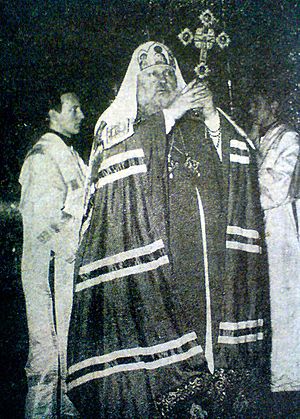Patriarch Pimen I of Moscow facts for kids
Quick facts for kids Pimen |
|
|---|---|
| Patriarch of Moscow and all the Rus' | |
 |
|
| Church | Russian Orthodox Church |
| See | Moscow |
| Enthroned | 3 June 1971 |
| Reign ended | 3 May 1990 |
| Predecessor | Alexy I |
| Successor | Alexy II |
| Orders | |
| Ordination | 25 January 1932 |
| Consecration | 17 November 1957 by Alexy I of Moscow |
| Personal details | |
| Birth name | Sergey Mikhailovich Izvekov |
| Born | July 23, 1910 Kobylino village, Kaluga Governorate, Russian Empire |
| Died | May 3, 1990 (aged 79) Moscow, Russian SFSR, Soviet Union |
| Nationality | Russian |
| Denomination | Eastern Orthodox Church |
Patriarch Pimen (Russian: Патриарх Пимен), born Sergey Mikhailovich Izvekov, was a very important leader of the Russian Orthodox Church. He was the 14th Patriarch of Moscow and led the church from 1970 until he passed away in 1990. He was born on July 23, 1910, and died on May 3, 1990.
Contents
Early Life and Church Path
Sergey Mikhailovich Izvekov was born in 1910 in a small village called Kobylino. His family was very religious. When he was young, his family moved to a town called Bogorodsk, which is now Noginsk.
When he was 15, on December 5, 1925, he became a young monk at Sretensky Monastery in Moscow. He took his final vows to become a monk at age 17, on October 4, 1927. He was given the name Pimen. He became a hierodeacon (a monk who is also a deacon) in 1930. The next year, in 1931, he became a hieromonk (a monk who is also a priest).
Life During World War II
In the summer of 1940, Pimen started studying literature at a university. He also worked as a teacher. When World War II began, he joined the Red Army in August 1941.
After the war, from 1945 to 1946, he was ill and needed treatment. After he recovered, he continued his service as a priest in different churches.
Rising Through the Church Ranks
Pimen moved to Odessa in 1946, where he took on more important roles in the church. He became a treasurer and then a secretary for the church administration in Rostov.
In 1949, he was appointed the leader of the Pskov-Caves Monastery. In 1950, he was given the title of Archimandrite, which is a high rank for a monk-priest. Later, he moved to a similar role at the famous Trinity Lavra of St. Sergius monastery in 1954.
On November 17, 1957, Pimen became a bishop. This was a very important step in his church career. He then served as a bishop in different areas, including Dmitrov and Tula. In 1960, he was made an archbishop, and in 1961, he became a Metropolitan of Leningrad. These are all very high positions in the church.
Becoming Patriarch
After Patriarch Alexius I passed away in 1970, Metropolitan Pimen was chosen to be the temporary head of the church. This role is called Patriarchal Locum Tenens.
A special meeting of the Russian Orthodox Church, called a Local Council, was held in May 1971. On June 2, 1971, Metropolitan Pimen was chosen to be the new Patriarch of Moscow and All Russia. He officially began his role on June 3, 1971.
Leading the Church in Difficult Times
Patriarch Pimen had a very challenging job. He led the Christian church in the Soviet Union, which was officially an atheist country. This meant the government did not believe in religion and often tried to limit the church's activities.
Patriarch Pimen worked with the government on some projects, especially those related to peace. He took part in many "peace movement" meetings that the government supported. He even received awards for his work towards peace. For example, he was given the Soviet Peace Fund Medal and the Gold Medal "Fighter for Peace." He was also a member of the World Peace Council. In 1961, he received the Order of the Red Banner of Labour, a high award in the Soviet Union.
Near the end of his time as Patriarch, he organized a huge celebration in 1988. This event marked the 1000th anniversary of the Christianization of Rus'. This was a very important moment because it happened as the Soviet Union was starting to change. The government began to stop its anti-religious actions. This celebration showed that the persecution of Orthodox Christianity in the Soviet Union was coming to an end.
When Patriarch Pimen passed away in 1990, the government did not try to control who would become the next Patriarch. This was a sign of the big changes happening in the country.
Images for kids
See also
 In Spanish: Pimen I para niños
In Spanish: Pimen I para niños


